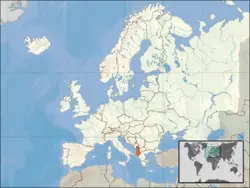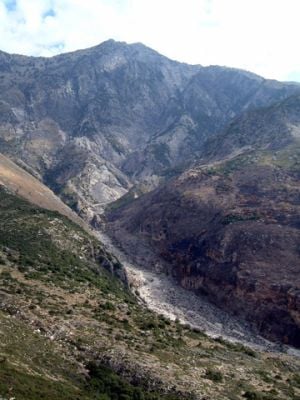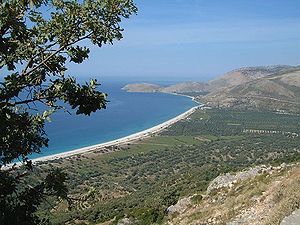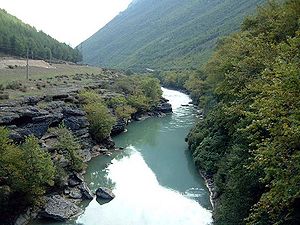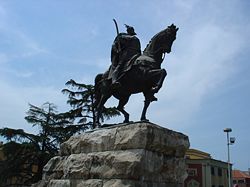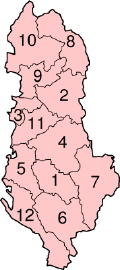Albania
- For the ancient country of Europe in the eastern Caucasus region on the western side of the Caspian Sea, see Caucasian Albania
| Republika e Shqipërisë Republic of Albania | |||||
| |||||
| Anthem: Rreth flamurit të përbashkuar | |||||
| Capital | Tirana 41°20′N 19°48′E | ||||
|---|---|---|---|---|---|
| Largest city | capital | ||||
| Official languages | Albanian | ||||
| Government | Republic | ||||
| - President | Alfred Moisiu | ||||
| - Prime Minister | Sali Berisha | ||||
| Independence | from the Ottoman Empire | ||||
| - Date | November 28 1912 | ||||
| Area | |||||
| - Total | 28 748 km² (139th) 11,100 sq mi | ||||
| - Water (%) | 4.7 | ||||
| Population | |||||
| - (July 2007 est.) estimate | 3,600,523[5] | ||||
| - Density | 123/km² 318.6/sq mi | ||||
| GDP (PPP) | 2007 estimate | ||||
| - Total | $19.818 billion[1] | ||||
| - Per capita | $6,259 | ||||
| HDI (2004) | 0.784 (medium) | ||||
| Currency | Lek (ALL)
| ||||
| Time zone | CET (UTC+1) | ||||
| - Summer (DST) | CEST (UTC+2) | ||||
| Internet TLD | .al | ||||
| Calling code | +355 | ||||
The Republic of Albania (Albanian: Republika e Shqipërisë, IPA [ɾɛˈpubliˌka ɛ ˌʃʨipəˈɾiːs] or simply Shqipëria) is a Balkan country in Southeastern Europe.
Despite its troubled history of foreign rule and dictatorship, the country has been classified as an emerging democracy since the 1990s.
Albania has played a relevant role in managing inter-ethnic tensions in south-eastern Europe and is continuing to work toward joining NATO and the European Union.
Geography
It borders Montenegro to the north, the Serbian province of Kosovo to the northeast, the Republic of Macedonia to the east, and Greece to the south. With the exception of the coastline, all Albanian borders are artificial. They were established in principle at the 1912-1913 conference of ambassadors in London. The northern and eastern borders were intended to separate the Albanians from the Serbs and Montenegrins; the southeast border was to separate Albanians and Greeks; the valuable western Macedonia lake district was to be divided among— Albania, Greece, and Yugoslavia —whose populations shared the area.
It has a coast on the Adriatic Sea to the west and a coast on the Ionian Sea to the southwest. It has a strategic location along Strait of Otranto, that links the Adriatic Sea to Ionian Sea and Mediterranean Sea.
Albania has a total area of 17,864 square miles (28,750 square kilometres), or slightly smaller than the state of Maryland in the United States. Its coastline is 362 kilometres long and stretches on the Adriatic Sea and the Ionian Sea.
The lowlands of the west face the Adriatic Sea. The 70 percent of the country that is mountainous is rugged and often inaccessible. The highest mountain is Mount Korab situated in the district of Dibra, reaching up to 9032 feet (2753 meters).
The country has a mild temperate climate, with cool, cloudy, wet winters and hot, clear, dry summers. The interior is cooler and wetter. The lowlands have mild winters, averaging about 44°F (7°C). Summer temperatures average 75°F (24°C), humidity is high, and the weather tends to be oppressively uncomfortable. Lowland rainfall averages from 40 inches (1000mm) to more than 60 inches (1500mm) annually, with the higher levels in the north. Nearly 95 percent of the rain falls in the winter.
Much of the plain's soil is of poor quality. Far from offering a relief from the difficult interior terrain, the alluvial plain is often as inhospitable as the mountains. Good soil and dependable precipitation, however, are found in intermontane river basins, in the lake district along the eastern frontier, and in a narrow band of slightly elevated land between the coastal plains and the interior mountains.
The three lakes of easternmost Albania, Lake Ohrid (Liqeni Ohrit), Big Prespa Lake (Prespa e Madhe), and Small Prespa Lake (Prespa e Vogël), are remote and picturesque.
The Drin River is the largest and most constant stream. The Semani River and Vjosa River are the only other rivers that are more than 100 miles (160km) long and have basins larger than 1000 square miles (2600 square kilometers). These rivers drain the southern regions and, reflecting the seasonal distribution of rainfall, are torrents in winter and nearly dry in the summer, in spite of their length. With the exception of the Drini i Zi River, which flows northward and drains nearly the entire eastern border region before it turns westward to the sea, most of the rivers in northern and central Albania flow fairly directly westward to the sea.
In its natural state, the coastal belt is characterized by low scrub vegetation, varying from barren to dense. There are large areas of marshlands and other areas of bare, eroded badlands. Where elevations rise slightly and precipitation is regular—in the foothills of the central uplands, for example—the land is highly arable. Marginal land is reclaimed wherever irrigation is possible. and fauna
Natural hazards include destructive earthquakes, tsunamis occur along southwestern coast, floods and drought.
Environmental issues include deforestation, soil erosion, as well as water pollution from industrial and domestic effluents.
Tirana is the capital and largest city of the Republic of Albania. It was founded in 1614 by Sulejman Pasha and became Albania's capital city in 1920. In 2005, its population was officially estimated at 585,756. Other cities are Durrës, Elbasan, Shkodër, Gjirokastër, Vlorë, Korçë and Kukës.
History
Prehistory
Most historians[citation needed] believe that Albanians are direct descendants of, and get their name from, an Illyrian tribe.
The lands that are today inhabited by Albanians were first populated in the Paleolithic Age (Stone Age), over one hundred thousand years ago. The first areas settled were those with favourable climatic and geographic conditions. In Albania, the earliest settlements have been discovered in the Gajtan cavern (Shkodra), in Konispol, at Mount Dajti, and at Xara (Saranda)[citation needed]. Primitive peoples lived in secluded groups, mainly in dry caves. They used stones and bones as their tools. Places such as caverns and lowlands close to rivers were used. In any case, the tools from this age were simple. Paleolithic peoples gathered fruits from plants and hunted wild animals.
The population of Albanian lands increased in the Neolithic age. People began to abandon caverns and settle in open areas. Neolithic people were more prone to build their settlements in open fields or next to rivers. A large number of such settlements are discovered in Albania, Kosovo, Montenegro, and the Republic of Macedonia. [citation needed]
Pelasgians
The Bronze Age is characterized with shifting demographics. Stockbreeding people came from the east around the mid 3000s B.C.E. to the early 2000s B.C.E. They mixed with the indigenous peoples and thus created the Indo-European peoples of the Balkans. This population is believed to be the ancient Pelasgians, which have been mentioned frequently by ancient writers such as Homer, Herodotus, and Thucydides. The Pelasgians are known as the most ancient inhabitants of the Balkan Peninsula, living before Illyrian or Greek times. Several different opinions arise when their ethnicity is analyzed. A theory dating back to the seventeenth century, and most popular during the Albanian Rilindja (Rebirth) in the nineteenth century, has attempted to connect the Pelasgian language with Albanian. The most active supporter of this theory was Austrian linguist Hahn. Today, however, Albanian is universally classified as an Indo-European (i.e. non-indigenous) language by linguists. Template:Albanians The differentiation of populations by ethnicity began during the Bronze Age. Herodotus, an ancient Greek historian in the fifth century B.C.E., writes about the Pelasgians that continued to live in Greece. According to him, the language of the Pelasgians was different from Greek, but later assimilated into Greeks.They dealt with agriculture and the sea and were excellent builders. The Pelasgians built the wall around the Acropolis of Athens and were rewarded with lands in Attica by the Athenians.
Illyrians
The Illyrians created and developed their culture, language and anthropological features in the western part of the Balkans, where ancient writers mention them in their works. The regions that the Illyrians inhabited are expansive. They include the entire western peninsula, north to central Europe, south to the Ambracian Gulf (Preveza, Greece), and east around the Lyhind Lake (Ohrid Lake). Other Illyrian tribes also migrated and developed in Italy. Among them were the Messapii and Iapyges. The name 'Illyria' is mentioned in works since the fifth century B.C.E. while some tribe names are mentioned as early as the twelfth century B.C.E. by Homer. The ethnic formation of the Illyrians, however, is much older.
The beginning of Illyrian origins in by the fifteenth century B.C.E., from the mid-Bronze Age, when Illyrian ethnic features began to form. By the Iron Age, the Illyrians were fully distinct and had inherited their developing anthropological features and language from the Neolithic and Bronze Ages. The old theory that the Illyrians came from Central Europe during the seventh to ninth centuries has been disproved and disbanded by studies performed following World War II. The fact that graves with urns, characteristic of Central Europe, are not found in Illyrian settlements severely damage the theory. Central European influence on the Illyrians is a result of cultural exchanges and movement of artisans.[2]
Roman and Byzantine rule
After being conquered by the Roman Empire, Illyria was reorganized as a Roman province. Illyricum was later divided into the provinces of Dalmatia and Pannonia, the lands comprising modern-day Albania mostly being included in the former. After the fall of the Western Roman Empire, the Byzantine Empire governed the region. It was also ruled by the Bulgarian and the Serbian Empire at various points in the Middle Ages.
Ottoman rule
In the Middle Ages, the name Arbania (see Origin and history of the name Albania) began to be increasingly applied to the region now comprising the nation of Albania. From 1443 to 1468 Gjergj Kastrioti Skanderbeg led a successful resistance against the invading Ottomans. After the death of Skanderbeg, resistance continued until 1478, although with only moderate success. The loyalties and alliances created and nurtured by Skanderbeg faltered and fell apart, and the Ottomans conquered the territory of Albania shortly after the fall of Kruje's castle. Albania then became part of the Ottoman Empire. Following this, many Albanians fled to neighboring Italy, mostly to Calabria and Sicily. The majority of the Albanian population that remained converted to Islam. They would remain a part provinces of İşkodra, Manastır and Yanya of the Ottoman Empire until 1912.
Effects of the Balkan Wars
After the Second Balkan War, the Ottomans were removed from Albania and there was a possibility of some of the lands being absorbed by Serbia and the southern tip by Greece. This decision angered the Italians, who did not want Serbia to have an extended coastline, and it also angered the Austro-Hungarians, who did not want a powerful Serbia on their southern border. Despite Serbian, Montenegrin, and Greek occupation forces on the ground, and under immense pressure from Austria-Hungary, it was decided that the country should not be divided but instead consolidated into the Principality of Albania. From 1925, the country was ruled by President Ahmet Zogu. After ruling Albania for a few years, in 1928 he declared himself King Zog I, the first Albanian monarch since Gjergj Kastriot Skenderbej.
Monarchy, King Zog I
After the Albanian government changed hands for a few years, Ahmet Zogu came to power. After ruling Albania for a few years, he declared himself "King Zog, the First Albanian Monarch." He styled himself a European king, married Hungarian princess Geraldine Apponyi de Nagy-Apponyi, and introduced the European style of life to the Albanian people after centuries of living an eastern lifestyle [citation needed]. His reign ended when the communists took power after the Second World War. After the fall of the communist government, his son Leka, Crown Prince of Albania and the royal family returned to Albania on June 28 2002.
The Second World War
Italy invaded Albania on 7 April 1939, meeting little resistance, and took control of the country. During this time, the Italians annexed parts of Montenegro, Kosovo and Northern Greece to the country. This led to an ironic situation for the nationalists: although the country was occupied, the dream of an Ethnic Albania was realized. Albanian communists and nationalists actively fought a partisan war against the Italian and German invasions in World War II. The socialists (most often called communists) took over after World War II. In November 1944, the communists gained control of the government under the leader of the resistance, Enver Hoxha. The Communist Party was created on November 8, 1941 with the help of Bolshevik Communist Parties, under the guidance of the Yugoslav Communist Party.
Totalitarian state
For the many decades under his totalitarian domination, Hoxha created and destroyed relationships with Yugoslavia, the Soviet Union, and China. Towards the end of the Hoxha era, Albania was isolated, first from the capitalist West (Western Europe, North America and Australia) and later even from the communist East. Enver Hoxha died in 1985. There are statistics which show that during this period about 6000 Albanian citizens were executed for political reasons. Despite this, the quality of life improved as both life expectancy and literacy showed large gains and economic growth continued until the mid 1970s.[citation needed]
The rise of democracy
The first massive anti-communist protests took place in July 1990. Shortly afterwards, the communist regime under Ramiz Alia carried out some cosmetic changes in the economy. At the end of 1990, after strong student protests and independent syndicated movements, the regime accepted a multiparty system. The first pluralist general elections were held on March 31, 1991 and saw the Communist Party (PPSH) win the majority. Democratic parties accused the government of manipulation and called for new elections, which were held on March 22, 1992 and resulted in a democratic coalition (composed of the Democratic Party, the Social-Democrats, and the Republican Party) coming to power.
In the general elections of June 1996 the Democratic Party won an absolute majority and the results [citation needed], winning over 85% of parliamentary seats. In 1997 widespread riots erupted after the International Monetary Fund forced the state to liberalise banking practices. Many citizens, naive to the workings of a market economy, put their entire savings into pyramid schemes. In a short while, $2 billion (80% of the country's GDP) had been moved into the hands of just a few pyramid scheme owners, causing severe economic troubles and civic unrest. Police stations and military bases were looted of millions of Kalashnikovs and other weapons. Anarchy prevailed,[3] and militia and even less-organized armed citizens controlled many cities. Even American military advisors left the country for their own safety. The government of Aleksander Meksi resigned and a government of national unity was built. In response to the anarchy[citation needed], the Socialist Party won the early elections of 1997 and Berisha resigned the Presidency.
However, stability was far from being restored in the years after the 1997 riots. The power feuds raging inside the Socialist Party led to a series of short-lived Socialist governments. The country was flooded with refugees from neighboring Kosovo in 1998 and 1999 during the Kosovo War. In June 2002, a compromise candidate, Alfred Moisiu, a former general, was elected to succeed President Rexhep Meidani. Parliamentary elections in July 2005 brought Sali Berisha, as leader of the Democratic Party, back to power, mostly owing to Socialist infighting and a series of corruption scandals plaguing the government of Fatos Nano.[citation needed]
The Euro-Atlantic integration of Albania has been the ultimate goal of the post-communist governments. Albania's EU membership bid has been set as a priority by the European Commission. On 2006 Albania signed a Stabilization and Association Agreement the EU, thus completing the first major step towards joining the bloc[citation needed]. Albania, along with Croatia and Macedonia, is also expected to receive an invitation to join NATO in 2008.[citation needed]
The workforce of Albania has continued to migrate to Greece, Italy, Germany, other parts of Europe, and North America. However, the migration flux is slowly decreasing, as more and more opportunities are emerging in Albania itself as its economy steadily develops.[4]
Counties and districts
Albania is divided into twelve counties (Albanian: official qark/qarku, but often prefekturë/prefektura), sometimes translated as prefecture). Each county is subdivided into several districts:
| County | Districts | Capital | |
|---|---|---|---|
| 1 | Berat | Berat, Kuçovë, Skrapar | Berat |
| 2 | Dibër | Bulqizë, Dibër, Mat | Peshkopi |
| 3 | Durrës | Durrës, Krujë | Durrës |
| 4 | Elbasan | Elbasan, Gramsh, Librazhd, Peqin | Elbasan |
| 5 | Fier | Fier, Lushnjë, Mallakastër | Fier |
| 6 | Gjirokastër | Gjirokastër, Përmet, Tepelenë | Gjirokastër |
| 7 | Korçë | Devoll, Kolonjë, Korçë, Pogradec | Korçë |
| 8 | Kukës | Has, Kukës, Tropojë | Kukës |
| 9 | Lezhë | Kurbin, Lezhë, Mirditë | Lezhë |
| 10 | Shkodër | Malësi e Madhe, Pukë, Shkodër | Shkodër |
| 11 | Tirana | Kavajë, Tirana | Tirana |
| 12 | Vlorë | Delvinë, Sarandë, Vlorë | Vlorë |
Demographics
95% of the population are ethnic Albanians. The 5% minorities include Greeks, Macedonians (ethnic group), Roma (Gypsies), Egyptians (Balkans), Vlachs and Italians. The dominant language is Albanian, with two main dialects, Gheg and Tosk. Many Albanians are also fluent in English, Greek, Italian and French.
As a part of the Ottoman Empire, Albania became a mostly Muslim (see Islam in Albania) territory. During the communist regime, religion was officially banned, and Albania was proclaimed as the first and only Atheist state in the world. Today, with the freedom of religion and worship, Albania contains numerous religions and denominations; however, within a muslim majority that may amount to 75% of the total population.[5][6][7][8] Other main religions of the world also have some small representation in Albania. Religious fanaticism has never been a problem,[9] with people from different religious groups living in peace. Interreligious marriage is very common, and an immensely strong sense of Albanian identity has tended to bind Albanians of all religious practices together.[10]
Economy
Since the fall of communism in 1990, Albania has launched economic programmes towards a more open-market economy[citation needed]. The democratically elected government that assumed office in April 1992 launched an ambitious economic reform programme to halt economic deterioration and put the country on the path toward a market economy[citation needed]. Key elements included price and exchange system liberalisation, fiscal consolidation, monetary restraint, and a firm income policy[citation needed]. These were complemented by a comprehensive package of structural reforms, including privatisation, enterprise, and financial sector reform, and creation of the legal framework for a market economy and private sector activity. Most prices were liberalised and are now approaching levels typical of the region[citation needed]. Most agriculture, state housing, and small industry were privatised, along with transportation, services, and small and medium-sized enterprises[citation needed]. After severe economic contraction following 1989, the economy slowly rebounded, finally surpassing its 1989 levels by the end of the 1990s. GDP per capita. Since prices have also risen, however, economic hardship has continued for much of the population. In 1995, Albania began privatizing large state enterprises. Since 2000, Albania has experienced a more rapid expansion of its economy.[citation needed]
Following the signing of the Stabilisation and Association Agreement in June/July 2006, EU ministers urged Albania to push ahead with reforms, focusing on press freedom, property rights, institution building, respect for ethnic minorities and observing international standards in municipal elections.
Albania's coastline on the Ionian Sea, especially near the Greek tourist island of Corfu, is becoming increasingly popular with tourists due to its relatively unspoiled nature and its beaches. The tourism industry is growing rapidly.
Notes and references
This article contains material from the Library of Congress Country Studies, which are United States government publications in the public domain.
This article contains material from the CIA World Factbook which, as a U.S. government publication, is in the public domain.
- ↑ Source for Albania GDP information IMF Albania Data
- ↑ "The Illyrians"
- ↑ http://libcom.org/history/1997-the-albanian-insurrection
- ↑ Gillian Gloyer (2006). Albania, 2nd ed, Bradt Travel Guides.
- ↑ US Department of State - International Religious Freedom Report 2006 - [1]
- ↑ L'Albanie en 2005 - [2]
- ↑ Zuckerman, Phil. "Atheism: Contemporary Rates and Patterns ", chapter in The Cambridge Companion to Atheism, ed. by Michael Martin, Cambridge University Press: Cambridge, UK (2005) [3]
- ↑ Goring, Rosemary (ed). Larousse Dictionary of Beliefs & Religions (Larousse: 1994); pg. 581-584. Table: "Population Distribution of Major Beliefs" [4]
- ↑ http://www.state.gov/g/drl/rls/irf/2004/35434.htm
- ↑ http://www.britannica.com/eb/article-42625
See also
|
|
|
|
- Lists
- List of Albania-related articles
- List of Albanians
- List of Albanian writers
- List of Albanian-Americans
External links
 Wikimedia Atlas of Albania, holding maps related to Albania.
Wikimedia Atlas of Albania, holding maps related to Albania.- Presidency of Albania
- The Albanian Parliament
- Albanian Institute of Statistics
- Department of Information
- Links to governmental sites
- OPIC Guide on Albania
- CIA World Factbook entry on Albania
- National Tourism Organization Albania's official website for travel & tourism information.
- Travel guide to Albania from Wikitravel
- Albania travel guide Bradt Travel Guides
- VIVAlbania, hospitality and ecotourism in Albania
- Tourism, Krujë
- Treasure of the national library of Albania
Credits
New World Encyclopedia writers and editors rewrote and completed the Wikipedia article in accordance with New World Encyclopedia standards. This article abides by terms of the Creative Commons CC-by-sa 3.0 License (CC-by-sa), which may be used and disseminated with proper attribution. Credit is due under the terms of this license that can reference both the New World Encyclopedia contributors and the selfless volunteer contributors of the Wikimedia Foundation. To cite this article click here for a list of acceptable citing formats.The history of earlier contributions by wikipedians is accessible to researchers here:
The history of this article since it was imported to New World Encyclopedia:
Note: Some restrictions may apply to use of individual images which are separately licensed.


